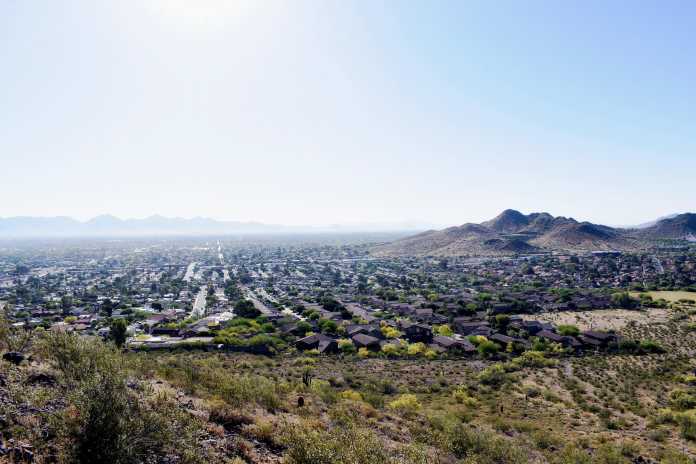A recent article posted at Oilprice.com claims that recent warming trends in Phoenix, Arizona are due primarily to increasing atmospheric carbon dioxide levels in the atmosphere. This is false. Data show that the high levels of warming, especially at night and as measured at an airport, are primarily due to urbanization over time, with the modest warming of the past hundred-plus years playing a very small part in comparison.
The article, “Explaining The Heat Wave: Separating Weather From Climate Change,” written by Robert Rapier, begins by correctly identifying the difference between weather and climate, explaining that weather is a shorter term event whereas climate is over “years, decades, or centuries.”
What is not true is Rapier’s assertion that the warming over the past 50 or so years in Phoenix has been mostly driven by climate change caused by rising atmospheric carbon dioxide levels, and worse, that the trend will cease only when people curtail emissions of carbon dioxide.
The top ten hottest years in Phoenix have been in the last 20 years, Rapier says, and the ten coldest are mostly from earlier in the 20th century. Atmospheric carbon dioxide concentrations are one thing that have changed since 1900, this is also true, but another factor that has a more immediate effect has changed as well.
Rapier even makes a comment that lends us a clue to what is going on.
He writes:
One of the biggest problems faced by cities like Phoenix is that the nights aren’t cooling off as much as in the past. For example, in the 1970s the average low temperature in Phoenix was 59 degrees F. During the previous decade, that had risen to nearly 65 degrees. That’s a substantial increase for an annual average.
This is a known effect of the Uban Heat Island (UHI). As described by meteorologist Anthony Watts in “No, E&E News, Climate Change Has Not Caused Reno’s Rapid Warming,” the UHI is seen most clearly at night. This fact has been confirmed time and again, including for Phoenix itself. Phoenix’s nighttime low temperatures are reported by Arizona State University researchers to be 10 to 15°F higher than surrounding rural areas. An illustration of this effect can be seen in the thermal image of Phoenix below, where the city and rockier mountain areas are hotter than the surrounding rural parts of the region.

The UHI is because of the heat-absorbing property of concrete, asphalt, and other construction materials that make up cities. During the day, they heat up, and at night, release the heat of the day into the surrounding air. Additionally, heat sources like engines and air conditioning units contribute to higher city temperatures.
Arizona isn’t alone in this. The University of Nevada study “The Urban Heat Island Effect in Nevada” found that cities with over 1 million residents can be 1.8-5.4°F warmer during the day than surrounding areas, and over 20°F warmer at night.
In 1960, Phoenix only had a population of about 100,000 people. Today, it is over 1.6 million.
Climate scientists at Georgia Tech told the Associated Press in 2018 that research shows Phoenix’s UHI causes the city to warm at three times faster than the rest of the world – meaning that climate change itself cannot be the main driver of Phoenix’s extreme highs, especially at night.
Fairly egregiously considering what we know about UHI, Rapier admits that the recent record high daily low was measured at Sky Harbor Airport. That temperature station sits downwind of the tarmac. (See image from Google Earth below)

Consider, for comparison, Chandler Arizona, which is very close to Phoenix but has a much lower population of 275,987. On the night that the Sky Harbor Airport hit the record daily low temperature of 97°F, July 19th, weather stations in Chandler recorded lows closer to 86°F. That is an eleven-degree difference.
In fact the airport station itself appears to be inflating temperatures even within Phoenix, because other nearby stations downtown recorded nighttime lows closer to 92°F. This airport data is where Rapier’s decadal average lows data quoted above comes from as well.
Climate Realism has catalogued plenty of similar scenarios where the UHI inflates average highs and especially nighttime lows, here, here, and here, for just a few examples.
The closest Rapier gets to acknowledging the UHI is in one short statement towards the end of his essay, after explaining the influence of El Niño, “[l]ikewise, there are other factors that influence temperature,” he says. “That’s why global temperature doesn’t scale linearly with rising carbon dioxide temperatures.”
Close, but no cigar.
Even back in 2012, the American Meteorological Society published a paper describing how the UHI in Phoenix could be studied, as well as mitigated using carefully planned tree plantings and vegetation. The study references the Phoenix Urban Form project, which sought to do city planning with UHI in mind back in 2006. This is not new information.
Rapier should have considered all the factors that may be leading to higher temperatures in Phoenix instead of jumping straight to carbon dioxide as the main culprit. Although the average temperature of the planet has modestly warmed over the last hundred years, the influence of the Urban Heat Island effect is a much stronger local explanation for Phoenix warming trends. It would benefit Oilprice.com and their contributors’ trustworthiness to acknowledge these effects. Instead of pushing for an end to carbon dioxide emissions, they could push instead for local policies that help mitigate the UHI.





















Refreshing to read well-founded articles like this that debunk climate hysteria.